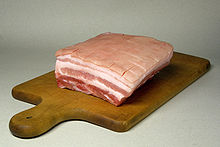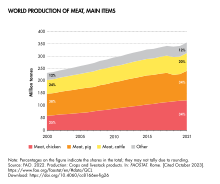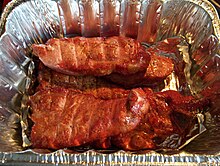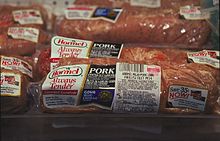Pork
It is the most commonly consumed meat worldwide,[1] with evidence of pig husbandry dating back to 5000 BCE.
The meat is highly prized in Asian cuisines, especially in China (including Hong Kong) and Northeast India,[3][4] for its fat content and texture.
[6] Charcuterie is the branch of cooking devoted to prepared meat products such as bacon, ham, sausage, terrines, galantines, pâtés and confit, primarily from pig.
The charcutier prepared numerous items, including pâtés, rillettes, sausages, bacon, trotters, and head cheese.
Due to the seasonal nature of the meat in Western culinary history, apples (harvested in late summer and autumn) have been a staple pairing to fresh pork.
Feijoada, the national dish of Brazil (also served in Portugal), is traditionally prepared with pork trimmings: ears, tail and feet.
[11] According to the USDA's Foreign Agricultural Service, nearly 100 million metric tons of pork were consumed worldwide in 2006 (preliminary data).
[17] In China, pork is preferred over beef for economic and aesthetic reasons; the pig is easy to feed and is not used for labour.
[19] Red braised pork (hong shao rou), a delicacy from Hunan Province, was one of Mao Zedong's favorite dishes.
In the Philippines, due to 300 years of Spanish colonization and influence, lechon, which is an entire roasted suckling pig, is a national delicacy.
[citation needed] China was the largest producer of pork in the world in 2020 followed by the European Union and the United States.
Danish roast pork or flæskesteg, prepared with crispy crackling is a national favourite as the traditional Christmas dinner.
In continental Europe, it is used primarily in cubes (lardons) as a cooking ingredient valued both as a source of fat and for its flavour.
[citation needed] Its myoglobin content is lower than that of beef, but much higher than that of chicken, so the USDA treats pork as a red meat.
As indicated by the Torah verses, pork is non-kosher because Jews may not consume an animal that possesses one trait but not the other of cloven hooves and regurgitating cud.
[33] The prohibition of swine-eating in Ancient Israelite cuisine, according to Douglas, was because the pig was raised by non-Israelites, ate carrion and did not fit into the classification of ungulates.
Harris disagrees and points out that Egyptians and Sumerians also restricted pigs and that goats also ate corpses, yet were not declared unclean in Ancient Israel.
Examples are Iran,[41] Mauritania,[42] Oman,[43] Qatar,[44] Saudi Arabia, Algeria, Turkmenistan, Uzbekistan, Tajikistan, Yemen, Somalia, Sudan, Afghanistan, Djibouti, Kuwait, Mali, Niger, Senegal, Gambia, Libya, Pakistan (except in some communities) and the Maldives.
[45] However, in other Muslim-majority countries with significant non-Muslim minorities, such as Indonesia (except the province of Aceh), Malaysia, Brunei, Lebanon, Iraq[citation needed], Tunisia, Egypt, Morocco, Bahrain, Bangladesh, Kyrgyzstan, Kazakhstan, Jordan, Albania, Azerbaijan, Turkey, Bosnia and Herzegovina, Kosovo, Syria, Sierra Leone, Guinea, Chad and the United Arab Emirates (except the Emirate of Sharjah), pork is available in hotels, restaurants and supermarkets that cater to a significant non-Muslim population.
But if someone is compelled by necessity—neither driven by desire nor exceeding immediate need—then surely your Lord is All-Forgiving, Most Merciful.”He has only forbidden you ˹to eat˺ carrion, blood, swine, and what is slaughtered in the name of any other than Allah.
[49][50] Undercooked or untreated pork may harbour pathogens, or can be recontaminated after cooking if left exposed for a long period of time.
In one instance, the Food Safety and Inspection Service (FSIS) detected Listeria monocytogenes in 210 kg (460 lb) of Polidori brand fully cooked pork sausage crumbles, although no one was made ill from consumption of the product.
One of the more common is Taenia solium, a type of tapeworm, which may transplant to the intestines of humans after consuming undercooked meat.
[55] Pork may be the reservoir responsible for sporadic, locally acquired cases of acute hepatitis E (HEV) reported in regions with relatively mild climates.
From 2002 to 2007, an annual average of 11 cases per year were reported in the United States; the majority were from consuming wild game or the source was unknown.
The number of cases has decreased because of legislation prohibiting the feeding of raw meat garbage to hogs, increased commercial and home freezing of pork, and the public awareness of the danger of eating raw or undercooked pork or wild game products.













